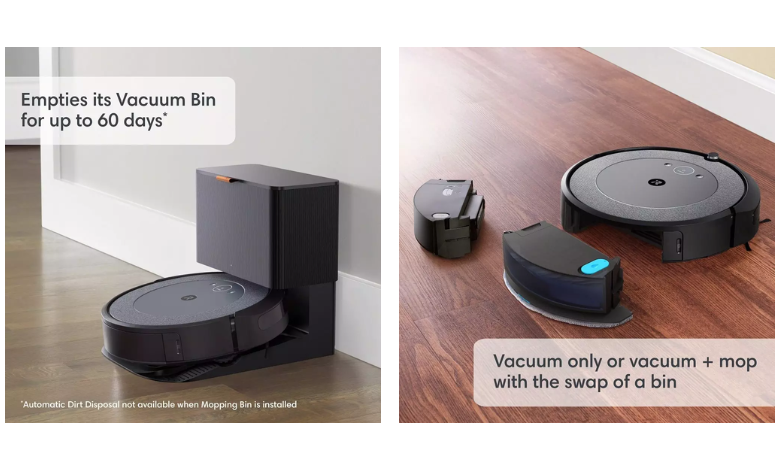
How to Monitor Your Home’s Cleanliness Efficiently with Smart Technology
Maintaining a clean home can be a challenge, especially when balancing work, personal life, and household tasks. Thankfully, there are innovative solutions that can help you stay on top of cleanliness, without demanding much of your time. One such solution is utilizing a self-emptying robot vacuum and mop system that can handle various cleaning tasks autonomously. The right smart cleaning system can simplify the cleaning process and ensure your home remains tidy day in and day out.
In this guide, we’ll explore how to monitor and manage your home’s cleanliness with smart technology, offering insights into the features and benefits of modern robot vacuums that incorporate advanced obstacle detection, self-emptying functions, and smart mapping.
The Benefits of Using Smart Robot Vacuums and Mops

Smart robot vacuums and mops come equipped with features designed to optimize your cleaning routine. These devices are a game changer for busy individuals or families, helping to maintain cleanliness without much effort.
By selecting the right smart vacuum, you can benefit from:
- Autonomous Cleaning: Cleans while you focus on other tasks.
- Self-Emptying Function: No need to manually empty the vacuum’s dustbin for up to 60 days.
- Obstacle Detection: Avoids common household obstacles like pet waste and cords.
- Room-Specific Cleaning: Maps out your home and targets specific rooms for cleaning.
- Alexa Integration: Use voice commands to control cleaning schedules.
👉 Shop now to discover smart cleaning solutions that can simplify your routine!
How to Effectively Monitor a Robot Vacuum’s Cleaning Progress
Monitoring your robot vacuum’s performance can be done easily through your smartphone or voice assistant. Here are a few key strategies to ensure your vacuum is working at its best:
Smart Mapping and Room-by-Room Cleaning
Most advanced robot vacuums now feature smart mapping technology, which enables them to clean your home methodically by room.
- Smart mapping allows the vacuum to learn the layout of your home.
- This ensures that it can clean the entire space efficiently.
- You can set it to clean specific rooms based on your preferences.
By checking the progress via an app, you can see exactly where the vacuum has cleaned, and even schedule cleaning sessions for different rooms.
Set Cleaning Schedules for Optimal Monitoring
Smart robot vacuums can be set to clean at specific times of the day, which means you don’t have to worry about remembering when to turn them on.
- Use your app or Alexa voice commands to set a cleaning schedule.
- Adjust the settings if you need to postpone a session or switch between rooms.
Monitoring and adjusting schedules is a breeze with the app interface, ensuring that your vacuum cleans exactly when you need it.
Real-Time Notifications and Updates
One of the key features of a self-emptying vacuum is its ability to send real-time updates to your smartphone. You’ll be notified when the vacuum begins or finishes cleaning, or if it encounters an obstacle that it can’t navigate.
This functionality ensures that you are always in the loop without having to check on your vacuum manually.
👉 See more info here on how to manage your cleaning schedule for maximum convenience.
Why Obstacle Detection is Crucial for Efficient Cleaning
Another major benefit of modern robot vacuums is their ability to identify and avoid obstacles. With this feature, these devices are far more efficient in handling tricky areas in your home.
Avoiding Pet Waste
For homes with pets, one of the most helpful features is pet waste detection.
- The vacuum can recognize pet waste and avoid it, ensuring your floors stay clean and hygienic.
- You won’t have to worry about the vacuum accidentally spreading messes across the room.
Avoiding Cords and Other Small Obstacles
Robots are designed to steer clear of common household hazards like cords, toys, or small furniture.
- It won’t get stuck or damage your home’s wires, thanks to its advanced sensors.
- The vacuum works efficiently without constantly needing intervention from you.
This makes it a perfect solution for homes with kids, pets, or areas with lots of cords.
👉 Shop now to explore robot vacuums that expertly avoid obstacles and clean your home hassle-free!
Self-Emptying and Maintenance-Free Functionality
Maintaining a robot vacuum is usually easy, but some models offer added convenience with self-emptying bins. The iRobot Roomba Combo j5+ Self-Emptying Robot Vacuum & Mop takes this convenience to the next level. It automatically empties its dustbin after each cleaning session, meaning you won’t need to worry about the vacuum becoming full and needing to be emptied manually for up to 60 days.
- Self-emptying system: The vacuum empties its dustbin every 30 or 60 days, depending on the model.
- This eliminates the need for frequent maintenance and allows for longer cleaning sessions.

Tips for Keeping Your Vacuum in Top Shape
While these vacuums do most of the work for you, it’s still important to perform occasional maintenance:
- Clean the vacuum’s brush and wheels: Keep them free from hair and dirt.
- Check for software updates: Ensure the vacuum is using the latest technology and features.
These small tasks will help your vacuum function optimally for years.
👉 Learn more about how to keep your robot vacuum in great condition for long-lasting performance.
How to Shop for the Right Smart Vacuum
When it comes to purchasing a smart robot vacuum, there are a few features to keep in mind:
- Obstacle Avoidance: Look for models that detect and avoid common household hazards.
- App Integration: Ensure the vacuum connects with your smartphone for easy monitoring.
- Self-Emptying Bin: Consider a vacuum that empties itself for hassle-free use.
- Alexa Compatibility: Alexa integration adds an extra layer of convenience for controlling your vacuum via voice commands.
👉 Shop now to find the perfect vacuum for your cleaning needs.
By selecting the right robot vacuum, you can easily monitor its performance and maintain a clean home with minimal effort. For a more hands-off experience, consider models with advanced mapping and self-emptying features like the iRobot Roomba Combo j5+.
Conclusion
Incorporating smart technology into your cleaning routine is an excellent way to stay ahead of the mess without dedicating precious time. With features like smart mapping, obstacle detection, and self-emptying bins, modern robot vacuums make maintaining a clean home easier than ever. They can be customized to your needs with schedules, real-time updates, and even voice command control.
By selecting the right vacuum, such as the iRobot Roomba Combo j5+, you’ll save time and effort while keeping your home in pristine condition.
👉 Shop now to experience the future of home cleaning and find a smart vacuum that fits your lifestyle!


Leave a Reply